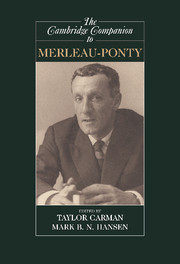Book contents
- Frontmatter
- Introduction
- 1 Merleau-Ponty and the Epistemological Picture
- 2 Sensation, Judgment, and the Phenomenal Field
- 3 Seeing Things in Merleau-Ponty
- 4 Motives, Reasons, and Causes
- 5 Merleau-Ponty and Recent Cognitive Science
- 6 The Silent, Limping Body of Philosophy
- 7 Merleau-Ponty and the Touch of Malebranche
- 8 A Phenomenology of Life
- 9 The Embryology of the (In)visible
- 10 Merleau-Ponty’s Existential Conception of Science
- 11 Between Philosophy and Art
- 12 Understanding the Engaged Philosopher: On Politics, Philosophy, and Art
- 13 Thinking Politics
- References
- Index
7 - Merleau-Ponty and the Touch of Malebranche
Published online by Cambridge University Press: 28 May 2006
- Frontmatter
- Introduction
- 1 Merleau-Ponty and the Epistemological Picture
- 2 Sensation, Judgment, and the Phenomenal Field
- 3 Seeing Things in Merleau-Ponty
- 4 Motives, Reasons, and Causes
- 5 Merleau-Ponty and Recent Cognitive Science
- 6 The Silent, Limping Body of Philosophy
- 7 Merleau-Ponty and the Touch of Malebranche
- 8 A Phenomenology of Life
- 9 The Embryology of the (In)visible
- 10 Merleau-Ponty’s Existential Conception of Science
- 11 Between Philosophy and Art
- 12 Understanding the Engaged Philosopher: On Politics, Philosophy, and Art
- 13 Thinking Politics
- References
- Index
Summary
The English-language reception of Merleau-Ponty's phenomenology of the body focuses mainly on two texts, Phenomenology of Perception and the posthumous The Visible and the Invisible. In the former, he interrogates the body as a site of mobility and spatiality, arguing that these fundamentally corporeal ways of relating to the world subtend and structure the intentionality of consciousness. In the latter work, the doctrine of intentionality is further displaced by a concept of the flesh, understood as a relation of tactility that precedes and informs intersubjective relations, necessarily disorienting a subject centered account. The flesh is not something one has, but, rather, the web in which one lives; it is not simply what I touch of the other, or of myself, but the condition of possibility of touch, a tactility that exceeds any given touch, and that cannot be reducible to a unilateral action performed by a subject. The most extended and controversial discussion of touch takes place in the final chapter of The Visible and the Invisible, “The Intertwining,” although that text, posthumously published and unfinished in many ways, can only suggest the radical challenge to a subject-centered conception of intentionality. Something is prior to the subject, but this “something” is not to be understood on the model of a substance.
- Type
- Chapter
- Information
- The Cambridge Companion to Merleau-Ponty , pp. 181 - 205Publisher: Cambridge University PressPrint publication year: 2004
- 5
- Cited by

